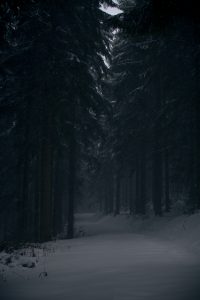Table of Contents
Writing an interesting campaign in any tabletop RPG can get amazingly difficult. Even when you have something where the lore is laid at your feet, like in Call of Cthulhu, it’s too easy to fall into tired cliches that will have your players yawning.
My goal for the month of October 2020 is to introduce as many creepy articles as possible for the season, and I think a great starting point is diving into the Lovecraftian mythos a bit. In this post, I’ll be telling you about several Lovecraftian deities that aren’t quite as well-known as the ever-present Cthulhu or Nyarlathotep.
Feel free to sprinkle them into your next Call of Cthulhu campaign to shock your players – even the ones that might consider themselves experts in the lore.
Read Also: Call of Cthulhu Keeper Tips
Lovecraftian Mythos 101
Okay, so the thing about the Lovecraftian mythos is it gets pretty darn confusing. HP Lovecraft encouraged his friends to add to his lore, so it continued to expand well after his death. There is an amazing breadth of deities to choose from.
Of course, that depends on what you consider a “Lovecraftian” deity. A purist might insist that only deities actually created by Lovecraft himself could be considered Lovecraftian. Out of all the deities considered part of the mythos, this would be only a small amount of them.
That’s why, in my list, I chose to look beyond gods that Lovecraft dreamt up. To find gods that are less known, I’m looking at contenders from all categories.
To that end, there are a few categories of gods in Lovecraft’s universe:
- Great Old Ones
- Great Ones
- Outer Gods
- Elder Gods
What’s the difference? I’ll try to keep it brief, but you might want to sit down for this because it gets kind of complex.
Great Old Ones
When most people who know anything about Lovecraft – even just a little – think about his deities, Cthulhu is probably the first one to come to mind. He’s one of the Great Old Ones.
These deities originally came from the vast reaches of space to dominate the earth. Nowadays, they’re all confined in the soft prison of a hopefully eternal sleep…unless someone awakens them.
In a nutshell, just think of them as space gods who are basically hibernating.
Great Ones
Don’t let the name “great ones” confuse you. No, it’s not a typo missing the world “old” – the Great Ones are indeed their own set of entities separate from the Great Old Ones.
These gods rule over the Dreamlands, a hidden world most famously explored in The Dream-Quest of Unknown Kadath, a story penned by HP Lovecraft himself. They are not considered powerful when compared with gods from the other categories.
An example of the Great Ones would be Nath-Horthath, the god of the Dreamlands city of Celephais.
Outer Gods
Outer Gods are…strange. Not that all other Lovecraftian gods aren’t, but these ones are particularly weird and there are a lot of theories out there about their actual location.
It’s said that the Outer Gods can be found in the center of the universe itself. It’s a bit more complicated than that, though, because they also kind of exist outside the scope of humanity’s reality. Some say the whole universe itself is sprung out of the Outer God Azathoth’s dreaming, and that should he awake, the world will end.
For the most part, it’s just easier to imagine them as deep space entities from far beyond the boundaries of our solar system. Azathoth is the most powerful, and he’s surrounded by a few Outer Gods that dance around him.
Elder Gods
After Lovecraft’s writings, the Elder Gods became a sort of opposing force to the Great Old Ones. Some of them are even seen as benevolent and willing to interact with humans, such as the god Nodens.
There isn’t honestly much more to say about them than that. Aside from Nodens, another example of an Elder God is Ulthar, whose name might be familiar to you from The Cats of Ulthar.
Meet the Terrifying and Underrated Lovecraftian Gods of Your Nightmares
Hastur

Maybe I’m being a little basic by including Hastur, because the King in Yellow isn’t exactly unknown. But I feel like when you compare him with Lovecraft’s other popular deities, he kind of just fades into the background.
Interestingly, Hastur was not created by HP Lovecraft, although he is nowadays known more for his role in Lovecraft’s work than his inception in Ambrose Bierce’s stories. Bierce originally envisioned Hastur as a benevolent god of shepherds, but he was reimagined in Robert Chambers’s short stories and then again by Lovecraft.
In the Lovecraftian mythos, Hastur is classified as a Great Old One. His nickname, the King in Yellow, references how he sometimes appears as a humanoid figure in tattered yellow robes and a mask. Another form he’s known for is a giant octopus-like creature, which might be due to the fact he’s actually Cthulhu’s half-brother.
Hastur is well-known for his influence over artists and writers. If you’ve got any creative types in your campaign, he could easily creep into their dreams and start controlling their artistic creations, twisting them into unnatural horrors from beyond.
Eihort
The nefarious god called Eihort was not originally created by Lovecraft. Instead, Eihort was created many years after Lovecraft’s death by a talented horror author named Ramsey Campbell in 1980.
I had to include Eihort after reading more about it. I’ll tell you why.
It is also called the God of the Labyrinth, because it lives within a network of underground tunnels in England. Should you be so unfortunate as to encounter the God of the Labyrinth, Eihort will offer you a deal: die an immediate and violent death, or allow it to essentially impregnate you with its inhuman brood.
Say you take Eihort up on its not-so-great deal. What does the parent of your future monster offspring look like? Well, Eihort is a giant oval-shaped entity “supported on a myriad of fleshless legs.” It also has eyes all over its gooey body.
Maybe it’s a good thing that you won’t live to see the surely hideous offspring you’d produce from such a monster. Even if you accepted Eihort’s offer, after all, you’ll die when its child comes to maturity and kills you.
I think this could potentially be a fun deity to throw into a campaign that takes place in England. Your players will be undoubtedly disturbed if they encounter it while exploring deep, vast, slimy underground tunnels.
Bokrug

Bokrug honestly doesn’t have a lot of lore to its name. But because it was originally created by Lovecraft, and because most people have never heard of this lizard-like god, I had to include it.
What little we do know is that Bokrug was worshipped by the amphibious beings of the city of Ib. It lived in a lake, where it slept peacefully until its people were destroyed by humans from the nearby city of Sarnath. Then, in a mighty fury, the reptilian god rose from its watery slumber and completely razed Sarnath, leaving not even the traces of ruins behind.
A lot could be left up for your interpretation here. If you’re willing to stretch the muscles of your imagination a bit, you could fill in the blanks and make this wrathful lizard deity into something awful. Say your party unwittingly stumbles upon the ruins of Ib, located somewhere in a dense forest or jungle, forgotten by the ravages of time…
And within the center of these inhuman ruins, there lies a deceptively still lake, nary a ripple on its glassy, dark surface. What could be hiding in its inky depths? What ancient, twisted monster could still lurk there, secretly bearing a grudge against the descendants of the humans who destroyed its people?
Tsathoggua

I sort of waffled back and forth on whether to include Tsathoggua, then decided to go for it. I think he’s also one of the lesser known gods in the mythos (for the average person, anyway), so he deserves a place here.
Tsathoggua’s appearance was kind of debated back when he was first created by author Clark Ashton Smith. Smith imagined him as a bat-like creature, while Lovecraft chose to portray him as looking like a toad. He’s categorized as a Great Old One.
There’s even some debate on his heritage. Lovecraft stated that Tsathoggua was the child of Yeb, and Smith insisted he was birthed by the gods Ghisguth and Zystulzhemgni.
The parentage doesn’t matter, though. I personally prefer to imagine Lovecraftian deities purely as gods, whole unto themselves rather than painting them in the familial drama that Greek mythology is drenched with.
So what does matter, in my opinion, is that this god is so powerful, he has a range of underlings to carry out his dark and unknowable bidding. Regardless of how he was born, he has the means to insinuate himself in the lives of your players, using formless spawn monsters made from black ichor.
Ithaqua
Maybe it’s because I come from the north, where legends of the wendigo originated, but I just couldn’t resist mentioning Ithaqua. Some of his other names include Wendigo and Wind-Walker.
He looks slightly humanoid, except he’s giant and has bright red and glowing eyes. You might be unfortunate enough to find him roaming in far northern arctic climates, where he stalks the snow, searching for victims.
If you’re lucky, all he’ll do is kill you. If you’re not lucky, he, like Eihort, might try to reproduce with you.
Some stories paint him as the horrific god of another world, where he’s rightfully and fearfully worshipped. Walking on the winds of space, he enters earth periodically to drag his victims back to his own icy world, where they’re forced to worship him.
Can you say “creepy arctic campaign?” If that interests you, Ithaqua is the perfect frigid deity for your unlucky party to rum amok of.
Lilith

Most people know of Lilith as the Judeo-Christian figure who was Adam’s first wife. What they might not know is that Lilith also had her own place in the Lovecraftian mythos, featured in Lovecraft’s story The Horror at Red Hook.
She’s unlike any other Lovecraftian god. Whereas most other Lovecraftian deities are inhuman, incomprehensible monstrosities that drive you mad with nothing more than a brief glance, Lilith is, well, gorgeous. She’s described as having lustrous black hair and seductive crimson lips.
If you think she’s hot, though, prepare to get screwed – and not in a good way. It’s said that those who get – ahem – turned on by her will be completely dominated by her and forced to carry out her will.
She’ll also sleep with you and use you to produce children. Unlike her, however, these children are far from beautiful. Instead, they become twisted, inhuman monsters that prowl the night.
She kind of makes me think of a vampire. I think she’d fit right into a mysterious campaign – say men are disappearing into the night, never to return, and rumors abound of unknown creatures stalking alleys after dark. As your party investigates, they’re caught off guard and drawn into Lilith’s damning charm.
It would be completely different from anything your party is expecting. In long tabletop campaigns, characters like this – who are entirely unique compared to the rest of their lore – can be a much-needed breath of fresh air.
Ubbo-Sathla

If you want to get really obscure with your CoC campaign, consider using Ubbo-Sathla. This monstrous deity is a member of the maddening Outer Gods.
How do you describe this being? It’s hard to say. It doesn’t have a distinct body; it’s just a giant bulbous mass hiding deep within the earth.
Most horrifyingly, Ubbo-Sathla is said to be the real creator of all life on the planet. It continuously births single-celled lifeforms. Although it is alleged to be the progenitor of life on earth, however, everything it touches basically dies.
Legend has it that one day, Ubbo-Sathla will devour all living creatures on earth, taking back what it once started long ago. It supposedly protects tablets containing the Elder Gods’ knowledge, but just dare your party to try and acquire those tablets. They’ll probably die.
And if someone were to somehow succeed in stealing them? I don’t imagine Ubbo-Sathla, the potential devourer of life on earth, would be happy.
Wrap Up
The seven gods I included in this list are just a tiny, tiny sample of the potential deities to choose from. If you’re ever feeling bored of the Lovecraftian mythos, thinking Cthulhu and Azathoth are all there is to it, keep in mind that there are plenty of other options.
I personally am drawn to Hastur – maybe because I’m a writer. I’ve had this cosplay idea for a costume inspired by him but have never gotten around to it. Maybe someday, right?
Feel free to let me know who some of your favorite Lovecraftian deities are in the comments below.



